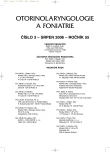-
Medical journals
- Career
Narrowing of Pharynx and Trachea in Children
Authors: P. Janoušek; Z. Kabelka; M. Marková
Authors‘ workplace: Subkatedra dětské otorinolaryngologie IPVZ, Praha přednosta doc. MUDr. Z. Kabelka ; Klinika ušní, nosní a krční 2. LF UK a FN Motol, Praha
Published in: Otorinolaryngol Foniatr, 55, 2006, No. 3, pp. 161-167.
Category: Original Article
Overview
Introduction:
Narrowing of respiratory pathways is classified according to the duration and the rapidity it develops to acute and chronic ones; etiology is the basis of classification to inborn and acquired stenoses. The trauma-related narrowing is called a stricture. The anatomical classification related to intramural and extramural ones. Based on the differences of treatment in children the authors analyze the experience with the diagnostics and therapy of chronic intramural subglottic stenoses and chronic intramural stenoses of cervical part of trachea in a separate communication. The cases are not frequent and literature describes only groups of patients collected at the specialized workplaces. It is therefore difficult to take a stand on epidemiology. The main diagnostic procedures include endoscopic examination, preferably by rigid laryngotracheobronchoscopy in general anesthesia, supplemented with data of imaging methods. The therapy is governed by the extent and etiology of the narrowing. All patients should be treated individually from the point of view of age as well as for frequently associated accompanying diseases and it is therefore impossible to create unambiguously valid “recommended procedures”.Methods:
In the selected five-year period of 2001-2005, 87 patients with the diagnosis of narrowed respiratory pathways have been treated at our Clinic of Ear, Nose and Neck, 2nd Medical Faculty, Charles University. In 57 patients the subglottic localization was encountered; 8 of them were congenital, the others were acquired. The heaviness was evaluated by a classification according to Myer. In 20 patients there was a narrowing of 1st degree of low significance; malignant tumors were found in three of them who were then operated on, whereas the other 217 patients were only under observation. The other 67 patients suffered from defect of 2nd to 3rd degree of varied significance. The bougie dilatation was used in 24 patients, and the balloon dilatation was applied in 12 patients. The surgery was indicated in 34 patients, eight subjects were operated on by endoscopy, whereas the open field operation was used in 26 individuals.Results:
In 34 patients operated on, endoscopy revealed only insignificant narrowing of respiratory pathways or small protrusions. These patients can get on more or less without limitations. There further prognosis is influence by the basic disease, though. Eight patients continue to be treated – in the program of balloon dilatation. Twelve patients continue to wear permanent cannulas. Seven patients are planned to be surgically treated, whereas the other are not due to expected lack of benefit related to the basic disease (centrally affected breathing, myopathies). Seven patients died from complications of the basic disease – a severe central affection.Conclusion:
The therapy of chronic stenosing processes of respiratory pathways in children is a complex chapter of children otorhinolaryngology for the frequent occurrence of co-morbidity as well as from the need of gradual enlargement of the diameter of respiratory tube, which is in contrast to the tendency of cicatrice forming. The care of these patients must be therefore secured by interdisciplinary approach due to other diseases affecting these patients. At our workplace there is a good experience with the treatment based primarily on dilatation with balloon probes, or by bougie dilatation – especially in stenoses of medium severity. The surgical therapy is taken into account in casers, where dilatation is not sufficient to solve the problem.Key words:
stenosis, stricture, larynx, trachea, children.
Labels
Audiology Paediatric ENT ENT (Otorhinolaryngology)
Article was published inOtorhinolaryngology and Phoniatrics

2006 Issue 3-
All articles in this issue
- Is it Important to Evaluate the Size of Adenoid Vegetations?
- A Comparison of Analgesic Efficiency in Patients after Tonsillectomy
- Standard and Puncture Dilatation Tracheostomy: Comparison of Results and Complications
- Biopsy of Sentinel Nodes in Head and Neck Carcinomas
- Narrowing of Pharynx and Trachea in Children
- Surgical Therapy of Malignant Tumors of Thyroid Gland in Children
- Functional Aspects in Morphology of Nasal Mucosa
- Otorhinolaryngology and Phoniatrics
- Journal archive
- Current issue
- Online only
- About the journal
Most read in this issue- Narrowing of Pharynx and Trachea in Children
- Standard and Puncture Dilatation Tracheostomy: Comparison of Results and Complications
- Is it Important to Evaluate the Size of Adenoid Vegetations?
- A Comparison of Analgesic Efficiency in Patients after Tonsillectomy
Login#ADS_BOTTOM_SCRIPTS#Forgotten passwordEnter the email address that you registered with. We will send you instructions on how to set a new password.
- Career

